Ken_McE
Flashlight Enthusiast
- Joined
- Jun 16, 2003
- Messages
- 1,687
Hi folks, I am writing up a guide to the Circline round fluorescent fixtures for eBay. I was hoping that one of my fellow kindly and well informed CPFers might take a peek and gently explain to me if they feel improvements are needed? :huh:
**********************************************************************
Several improvements incorporated as of March 17, thanks guys!
**********************************************************************
Fixtures that use the round Circline style fluorescent tubes can be a good choice in some situations. You can assume that a Circline tube will give the same amount of light as an incandescent bulb that uses about three to four times as much power, and will have a life expectancy that is about ten times as long as an incandescent.
Circlines are better than compact fluorescents (CFL's) in that you can put them in a fully enclosed fixture and the heat will not bother them. CFL's often say right on the box that they cannot be used in an enclosed fixture because they may overheat and die young. Circlines also don't care if you burn them base up, down, or sideways. Circlines share the weakness of all fluorescents, compact or not, that being turned on and off many times a day can shorten their lives.
You should be able to pick up a 54 watt Circline fixture for around $20 either on eBay or in a big box store. Such a fixture will use about 60 watts (the ballast uses power too) and produce the light of about a 175 watt incandescent bulb. If you buy in a store the bulbs will be separate, on eBay bulbs may be included.
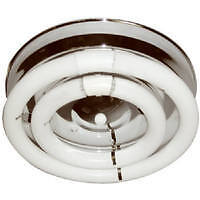
54 Watt "Coronet" style fixture uses one 22 and one 32 watt bulb, is cheap and effective, has retro/modern style. It is easy to add a shade to match any setting. Common on eBay and Lowes.
The tubes come in four common sizes:
6", 8", 12", 16". The inch measurement refers to the nominal size of the circle, measured from outside to outside. A given fixture will use either one or two bulbs, the one nested inside the other. The bulbs are widely available both online and off.
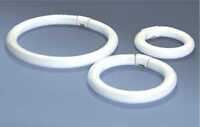
What do those numbers on the bulb mean?
Let's take a typical number like "FC16T9". The "FC" part means fluorescent, the "16" is the diameter of the bulb in inches, the "T9" means that the bulb has a tube shaped cross section and is 9/8's of an inch thick. T9 is the oldest and most common style. If you run across a bulb that says "T5" in this spot it is a more modern T5 bulb and needs a T5 ballast. The T5's are thinner, newer, and will give you more light per watt.
FC12T9/KB: Fluorescent, twelve inches across, Tube shaped cross section 9/8's of an inch thick. The "KB" part is a GE code for Kitchen & Bath.
FC8T9/D: Fluorescent, 8 inches across, T9 bulb, Daylight white color.
FC12T9/CW: Fluorescent, 12 inches across, T9 style, Cool white color.
FC6T9/CW Fluorescent, 6 inches across, T9 tube, Cool white color.
How well do they perform?
Six inch, 20 watt, 800 lumens, about equal to a 60 watt incandescent
Eight Inch, 22 watt, 925 lumens.........................70 watt incan
twelve Inch, 32 watt, 2,000 Lumens...............,...125 watt incan
Sixteen Inch, 40 watt, 2,500 Lumens..................140 watt
Ballasts come in two kinds, electromagnetic (AKA magnetic) and electronic. If you pick up an old fixture in a random auction it will have the old style magnetic ballast. These ballasts are big and heavy. They look like a small metal shoebox and have one or two sets of wires coming out that end in four socket plugs. These plugs mate up with the four pins on your tube. The advantage of the magnetic ballasts is that they come with any old fixture and are ready to work as when you open the box. Their disadvantages are that they may be slow to start, they may buzz or hum, and below fifty or sixty degrees F. (10 ~ 15 C) they may work slowly or poorly.
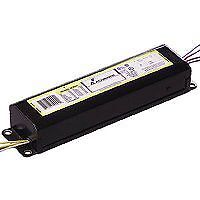
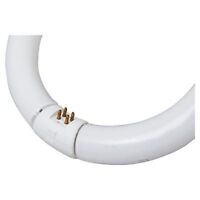
Typical Magnetic ballast. Note the four pins on the tube.
The newer electronic ballasts start instantly at temperatures down to about zero F (-17 C) and don't hum, buzz or flicker. Their only disadvantage is that they can be hard to find. Nobody seems to keep them in stock. People have been known to buy a cheap new Circline fixture, remove the ballast and and discard the fixture, because it is cheaper and easier than finding someone to order you a ballast.
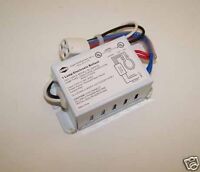
This electronic ballast has one plug so it only runs one bulb. Some will do two.
It is not really a good idea to use a ballast that has a different wattage than your bulb. Too strong of a ballast will overdrive your bulb and give it a short life. Underdriving it may not start it, may light only the ends of the tubes, and will not give full brightness
Quality of the light:
These tubes are available in Cool White (CW), sometimes Daylight White (DW) and Warm White. (WW) The CW is the old industry standard and the most common. They give the most light per watt, are the cheapest, and are widely available. Their disadvantage is that the light is somewhat unnatural and makes things look funny.
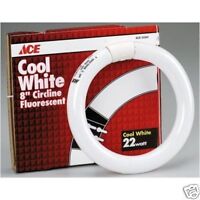
The WW has a warmer and somewhat more pleasant light, but is usually a little less bright than a CW. I have found that using one of each kind in a fixture gives a nice balance of brightness and quality. The most common WW is the GE "Kitchen & Bath" series.
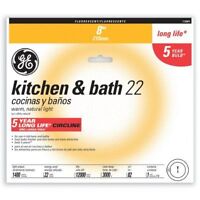
The DW's are somewhat rare, enough so that I have not used them, but I suspect that they are an improved CW.
New meaty Lowes Circline fixture.
GE details on various of their Circline tubes:
http://genet.gelighting.com/LightPr...10:Fluorescent_Standard&CATEGORY=Lamps_Linear Fluorescent_Circular_T9&BREADCRUMP=Fluorescent_Standard#T9
**********************************************************************
Several improvements incorporated as of March 17, thanks guys!
**********************************************************************
Fixtures that use the round Circline style fluorescent tubes can be a good choice in some situations. You can assume that a Circline tube will give the same amount of light as an incandescent bulb that uses about three to four times as much power, and will have a life expectancy that is about ten times as long as an incandescent.
Circlines are better than compact fluorescents (CFL's) in that you can put them in a fully enclosed fixture and the heat will not bother them. CFL's often say right on the box that they cannot be used in an enclosed fixture because they may overheat and die young. Circlines also don't care if you burn them base up, down, or sideways. Circlines share the weakness of all fluorescents, compact or not, that being turned on and off many times a day can shorten their lives.
You should be able to pick up a 54 watt Circline fixture for around $20 either on eBay or in a big box store. Such a fixture will use about 60 watts (the ballast uses power too) and produce the light of about a 175 watt incandescent bulb. If you buy in a store the bulbs will be separate, on eBay bulbs may be included.
54 Watt "Coronet" style fixture uses one 22 and one 32 watt bulb, is cheap and effective, has retro/modern style. It is easy to add a shade to match any setting. Common on eBay and Lowes.
The tubes come in four common sizes:
6", 8", 12", 16". The inch measurement refers to the nominal size of the circle, measured from outside to outside. A given fixture will use either one or two bulbs, the one nested inside the other. The bulbs are widely available both online and off.
What do those numbers on the bulb mean?
Let's take a typical number like "FC16T9". The "FC" part means fluorescent, the "16" is the diameter of the bulb in inches, the "T9" means that the bulb has a tube shaped cross section and is 9/8's of an inch thick. T9 is the oldest and most common style. If you run across a bulb that says "T5" in this spot it is a more modern T5 bulb and needs a T5 ballast. The T5's are thinner, newer, and will give you more light per watt.
FC12T9/KB: Fluorescent, twelve inches across, Tube shaped cross section 9/8's of an inch thick. The "KB" part is a GE code for Kitchen & Bath.
FC8T9/D: Fluorescent, 8 inches across, T9 bulb, Daylight white color.
FC12T9/CW: Fluorescent, 12 inches across, T9 style, Cool white color.
FC6T9/CW Fluorescent, 6 inches across, T9 tube, Cool white color.
How well do they perform?
Six inch, 20 watt, 800 lumens, about equal to a 60 watt incandescent
Eight Inch, 22 watt, 925 lumens.........................70 watt incan
twelve Inch, 32 watt, 2,000 Lumens...............,...125 watt incan
Sixteen Inch, 40 watt, 2,500 Lumens..................140 watt
Ballasts come in two kinds, electromagnetic (AKA magnetic) and electronic. If you pick up an old fixture in a random auction it will have the old style magnetic ballast. These ballasts are big and heavy. They look like a small metal shoebox and have one or two sets of wires coming out that end in four socket plugs. These plugs mate up with the four pins on your tube. The advantage of the magnetic ballasts is that they come with any old fixture and are ready to work as when you open the box. Their disadvantages are that they may be slow to start, they may buzz or hum, and below fifty or sixty degrees F. (10 ~ 15 C) they may work slowly or poorly.
Typical Magnetic ballast. Note the four pins on the tube.
The newer electronic ballasts start instantly at temperatures down to about zero F (-17 C) and don't hum, buzz or flicker. Their only disadvantage is that they can be hard to find. Nobody seems to keep them in stock. People have been known to buy a cheap new Circline fixture, remove the ballast and and discard the fixture, because it is cheaper and easier than finding someone to order you a ballast.
This electronic ballast has one plug so it only runs one bulb. Some will do two.
It is not really a good idea to use a ballast that has a different wattage than your bulb. Too strong of a ballast will overdrive your bulb and give it a short life. Underdriving it may not start it, may light only the ends of the tubes, and will not give full brightness
Quality of the light:
These tubes are available in Cool White (CW), sometimes Daylight White (DW) and Warm White. (WW) The CW is the old industry standard and the most common. They give the most light per watt, are the cheapest, and are widely available. Their disadvantage is that the light is somewhat unnatural and makes things look funny.
The WW has a warmer and somewhat more pleasant light, but is usually a little less bright than a CW. I have found that using one of each kind in a fixture gives a nice balance of brightness and quality. The most common WW is the GE "Kitchen & Bath" series.
The DW's are somewhat rare, enough so that I have not used them, but I suspect that they are an improved CW.
New meaty Lowes Circline fixture.
GE details on various of their Circline tubes:
http://genet.gelighting.com/LightPr...10:Fluorescent_Standard&CATEGORY=Lamps_Linear Fluorescent_Circular_T9&BREADCRUMP=Fluorescent_Standard#T9
Last edited:

